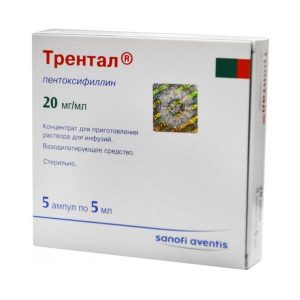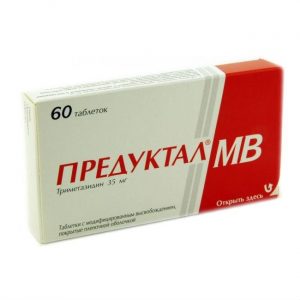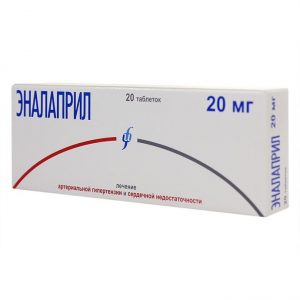Description
Release form
Film-coated tablets
Packing
30 pcs.
Pharmacological action
Pharmacodynamics
Bisoprolol – selective beta1-blocker, without its own sympathomimetic activity -, does not have a membrane-stabilizing effect. As with other beta1-blockers, the mechanism of action for arterial hypertension is unclear. At the same time, it is known that bisoprolol reduces the activity of renin in blood plasma, reduces the need for myocardium in oxygen, and reduces heart rate. It has hypotensive, antiarrhythmic and antianginal effects.
Blocking beta1-adrenoreceptors of the heart in low doses, it reduces catecholamine-stimulated cAMP production from ATP, reduces the intracellular calcium ion flow, inhibits all cardiac functions, and reduces AV conduction and excitability. If the therapeutic dose is exceeded, it has a beta2-blocking effect. OPSS at the beginning of drug administration, in the first 24 hours, increases (as a result of a reciprocal increase in alpha-adrenergic receptor activity and elimination of beta2-adrenergic receptor stimulation), after 1-3 days it returns to its original value, and with prolonged use, it decreases. The antihypertensive effect is associated with a decrease in minute blood volume, sympathetic stimulation of peripheral vessels, a decrease in the activity of the sympathoadrenal system (CAS) (of great importance for patients with initial hypersecretion of renin), restoration of sensitivity in response to a decrease in blood pressure and an effect on the central nervous system. With arterial hypertension, the effect develops after 2 5 days, a stable effect is observed after 1 2 months.
The antianginal effect is due to a decrease in myocardial oxygen demand as a result of decreased contractility and other myocardial functions, lengthening of diastole, and improved myocardial perfusion. By increasing the final diastolic pressure in the left ventricle and increasing the stretching of the muscle fibers of the ventricles, oxygen demand may increase, especially in patients with chronic heart failure (CHF).
When used in medium therapeutic doses, unlike non-selective beta-blockers, it has a less pronounced effect on organs containing beta2-adrenergic receptors (pancreas, skeletal muscle, smooth muscles of the peripheral arteries, bronchi and uterus), and does not cause carbohydrate metabolism the delay of sodium ions in the body, the severity of the atherogenic effect does not differ from the action of propranolol.
Pharmacokinetics
Bisoprolol is almost completely absorbed from the gastrointestinal tract, food intake does not affect absorption. Bioavailability is about 90%.
Tmax is 2 4 hours after oral administration. Binding to plasma proteins – 26 33%. It is metabolized in the liver, bisoprolol metabolites do not have pharmacological activity. T1 / 2 is 9-12 hours, which makes it possible to use the drug 1 time per day.
It is excreted by the kidneys – 50% unchanged, less than 2% – through the intestines.
Permeability through the blood-brain and placental barrier – low, excreted in small amounts with breast milk.
Indications
arterial hypertension
IHD (prevention of attacks of stable angina pectoris)
CHF (as part of combination therapy).
Contraindications
hypersensitivity to the drug and other beta-blockers
acute heart failure and heart failure in the decompensation phase requiring inotropic therapy
cardiogenic shock
collapse
AV block II ² II degree without pacemaker
sinoatrial blockade
sinus weakness syndrome
bradycardia (heart rate before treatment is less than 50 beats / min)
severe arterial hypotension (SBP less than 90 mmHg)
cardiomegaly (without signs of heart failure s) history of asthma and COPD with a history of
severe peripheral circulatory disorders
Raynaud’s syndrome
metabolic acidosis
pheochromocytoma (without the simultaneous use of alpha-blockers)
concomitant use of flactaphenin and c Ultrida
age up to 18 years (efficacy and safety not established).
Caution: desensitizing therapy
hyperthyroidism
type 1 diabetes mellitus and diabetes mellitus with significant fluctuations in blood glucose concentration
severe renal failure (Cl creatinine less than 20 ml / min)
severe hepatic impairment
psoriasis
AVI cardiac sardlosis cardiomyopathy
congenital heart defects or heart valve disease with severe hemodynamic disturbances
CHF with myocardial infarction over the past 3 months
depression (including a history of)
pheochromocytoma (the simultaneous use of alpha-blockers is mandatory)
a strict diet.
Use during pregnancy and lactation
Bisoprolol does not have direct cytotoxic, mutagenic and teratogenic effects, but has pharmacological effects that can have a harmful effect on the course of pregnancy and / or on the fetus or newborn. Usually beta-blockers reduce placental perfusion, which leads to a slowdown in fetal growth, fetal death, miscarriages or premature births. The fetus and the newborn baby may experience pathological reactions, such as intrauterine growth retardation, hypoglycemia, bradycardia.
The drug Biol ® should not be used during pregnancy, use is possible if the benefit to the mother outweighs the risk of side effects in the fetus and / or baby. In the case when treatment with Biol ® is considered as necessary, blood flow in the placenta and uterus should be monitored. and also observe the growth and development of the unborn child, and in case of adverse events regarding pregnancy and / or the fetus, apply alternative methods of therapy. You should carefully examine the newborn after childbirth. Symptoms of hypoglycemia and bradycardia usually occur during the first 3 days of life.
Breastfeeding period. There is no data on the penetration of bisoprolol into breast milk. Therefore, the use of Biol ® is not recommended for women during lactation.
If you need to use the drug during lactation, breastfeeding should be discontinued.
Special instructions
Do not abruptly interrupt treatment with Biol ® because of the risk of severe arrhythmias and myocardial infarction. Cancellation is carried out gradually, reducing the dose by 25% every 3-4 days.
Monitoring the status of patients taking Biol ® should include measuring heart rate and blood pressure (daily at the beginning of treatment, then once every 3-4 months), an ECG, determination of blood glucose concentration in patients with diabetes mellitus (1 time in 4-5 months).
In elderly patients, it is recommended to monitor renal function (1 time in 4-5 months).
The patient should be trained in the method of calculating heart rate and instructed on the need for medical advice for heart rate less than 50 bpm.
In the case of elderly patients with increasing bradycardia (heart rate less than 50 beats / min), a marked decrease in blood pressure (SBP less than 100 mm Hg), AV block, it is necessary to reduce the dose or stop treatment. Before starting treatment, it is recommended to study the function of external respiration in patients with a burdened bronchopulmonary history.
Patients using contact lenses should be aware that a decrease in tear fluid production is possible during treatment with the drug.
When using Biol ® in patients with pheochromocytoma, there is a risk of developing paradoxical arterial hypertension (unless effective blocking of alpha-adrenergic receptors has been previously achieved).
With hyperthyroidism, bisoprolol may mask certain clinical signs of hyperthyroidism (such as tachycardia). Abrupt withdrawal of the drug in patients with hyperthyroidism is contraindicated, since it can increase symptoms. With diabetes, it can mask tachycardia caused by hypoglycemia. Unlike non-selective beta-blockers, it practically does not enhance insulin-induced hypoglycemia and does not delay the restoration of blood glucose concentrations to normal values. With the simultaneous use of clonidine, its administration can be stopped only a few days after the withdrawal of the drug Biol ®.
It is possible to increase the severity of the hypersensitivity reaction and the lack of effect of the usual doses of epinephrine against the background of a burdened allergic history.
If it is necessary to carry out planned surgical treatment, the drug should be discontinued 48 hours before general anesthesia. If the patient took the drug before surgery, he should choose drugs for general anesthesia with a minimally negative inotropic effect.
Reciprocal vagus nerve activation can be eliminated by iv administration of atropine (1 ² 2 mg). Drugs that deplete the catecholamine depot (including reserpine) can enhance the effect of beta-blockers, so patients taking such combinations of drugs should be under constant medical supervision to detect a pronounced decrease in blood pressure or bradycardia.
Patients with bronchospastic diseases can be prescribed cardioselective beta-blockers with caution in case of intolerance and / or ineffectiveness of other antihypertensive drugs. With beta-blockers in patients with concomitant bronchial asthma, airway resistance may increase. If the dose of Biol ® is exceeded, in such patients there is a risk of developing bronchospasm.
In the case of patients with increasing bradycardia (heart rate less than 50 beats / min), a pronounced decrease in blood pressure (SBP less than 100 mm Hg), AV block, it is necessary to reduce the dose or stop treatment.
It is recommended that Biol ® therapy be discontinued if depression develops.
Do not abruptly interrupt treatment because of the danger of developing severe arrhythmias and myocardial infarction. Drug withdrawal is carried out gradually, reducing the dose for 2 weeks or more (reduce the dose by 25% in 3-4 days).
The drug should be discontinued before examining the concentration in the blood and urine of catecholamines, normetanephrine, vanillin mindic acid, and antinuclear antibody titers. In smokers, the effectiveness of beta-blockers is lower.
Effect on the ability to drive vehicles and perform other activities that require concentration and speed of psychomotor reactions. During the period of treatment with Biol ®, care must be taken when driving vehicles and performing other potentially dangerous activities that require an increased concentration of attention and speed of psychomotor reactions.
Composition
1 tablet contains: active substance: bisoprolol hemifumarate 2.5 mg
excipients: MCC calcium hydrophosphate starch maize croscarmellose sodium magnesium stearate hydrate palladium hydrate colloid dioxide titanium dioxide macrogol 4000 dye iron (III) oxide yellow dye iron (III) oxide red (for a dosage of 10 mg)
Dosage and administration
Inside, in the morning, on an empty stomach (before breakfast), during or after breakfast, 1 time per day with a small amount of liquid. Tablets should not be chewed or ground into powder.
In all cases, the regimen and dose are selected by the doctor individually for each patient, in particular, taking into account the heart rate and the patient’s condition.
Arterial hypertension and coronary heart disease
For arterial hypertension and coronary heart disease, Biol ® is used 5 mg once a day. If necessary, increase the dose to 10 mg once a day.
In the treatment of arterial hypertension and angina pectoris, the maximum daily dose is 20 mg 1 time / day.
CHF
Starting treatment of CHF with Biol ® requires a special titration phase and regular medical supervision.
A prerequisite for treatment with Biol ® is stable heart failure without signs of exacerbation.
Treatment of CHF with Biol ® begins in accordance with the following titration scheme. In this case, individual adaptation may be required, depending on how well the patient tolerates the prescribed dose, i.e. the dose can be increased only if the previous dose was well tolerated.
To ensure an appropriate titration process in the initial stages of treatment, it is recommended to use the drug in smaller doses.
The recommended starting dose is 1.25 mg (1/4 tab. 5 mg) 1 time per day. Depending on individual tolerance, the dose should be gradually increased to 2.5 mg (1/2 tablet of Biol ® 5 mg each), 3.75 mg (3/4 tablet 5 mg), 5 mg (1 tablet Biol ® 5 mg or 1/2 tablet. 10 mg), 7.5 mg (3/4 tablet. 10 mg) and 10 mg once a day with an interval of at least 2 weeks.
If an increase in the dose of the drug is poorly tolerated by the patient, a dose reduction is possible.
The maximum daily dose in the treatment of heart failure is 10 mg 1 time per day.
During titration, regular monitoring of blood pressure, heart rate and symptoms of increasing severity of heart failure is recommended. The worsening of the symptoms of heart failure is possible from the first day of the drug.
During or after the titration phase, a temporary deterioration in the course of heart failure, arterial hypotension, or bradycardia may occur. In this case, it is recommended first of all to pay attention to the selection of the dose of concomitant standard therapy. It may also be necessary to temporarily reduce the dose of Biol ® at 5 mg or cancel the treatment. After stabilization of the patient’s condition, a dose titration should be repeated or treatment should be continued.
Impaired renal or hepatic function
Impaired mild or moderate hepatic or renal function usually does not require dose adjustment. In severe renal impairment (creatinine Cl less than 20 ml / min) and in patients with severe liver disease, the maximum daily dose is 10 mg. Increasing the dose in such patients should be carried out with extreme caution.
Elderly patients
Dose adjustment not required.
Currently, there is insufficient data on the use of Biol ® 5 mg in patients with heart failure associated with type 1 diabetes mellitus, severe renal and / or liver dysfunction, restrictive cardiomyopathy, congenital heart defects, or hemodynamically caused heart disease. Also, until now, sufficient data have not been obtained regarding patients with heart failure with myocardial infarction over the past 3 months.
Side effects
The frequency of adverse reactions listed below was determined as follows (WHO classification): very often – at least 10% often – at least 1%, but less than 10% infrequently – at least 0.1%, but less than 1 % rarely – at least 0.01%, but less than 0.1% very rarely – less than 0.01%, including individual messages.
From the CCC side: very often – reduction in heart rate (bradycardia, especially in patients with heart failure), palpitations often – a marked decrease in blood pressure (especially in patients with heart failure), the manifestation of angiospasm (increased peripheral circulation disorders, a cold sensation in the extremities (paresthesia) infrequently – impaired AV conduction (up to the development of complete transverse blockade and cardiac arrest), arrhythmias, orthostatic hypotension, worsening of the course of heart failure with the development of peripheral edema (swelling of the ankles, feet shortness of breath), chest pain.
From the nervous system: often – dizziness, headache, asthenia, increased fatigue dullness, sleep disturbance, depression, anxiety rarely – confusion or short-term memory loss, nightmares, hallucinations, myasthenia gravis, tremors, muscle cramps. These phenomena are usually mild and usually disappear within 1 2 weeks after starting treatment .
On the part of the sensory organs: rarely – visual impairment, decreased lacrimation (should be taken into account when wearing contact lenses), tinnitus, hearing loss, ear pain is very rare – dry and sore eyes, conjunctivitis, taste disturbance.
From the respiratory system: infrequently – bronchospasm in patients with bronchial asthma or obstructive respiratory diseases rarely – allergic rhinitis nasal congestion.
From the digestive system: often – nausea, vomiting, diarrhea, constipation, dry oral mucosa, abdominal pain rarely – hepatitis, increased activity of liver enzymes (ALT, AST), increased bilirubin concentration, taste change.
From the side of the musculoskeletal system: infrequently – arthralgia, back pain.
From the genitourinary system: very rarely – impaired potency, weakening of libido.
Laboratory indicators: rarely – increased concentration of triglycerides in the blood in some cases – thrombocytopenia, agranulocytosis, leukopenia.
Allergic reactions: rarely – skin itching, rash, urticaria.
From the skin: rarely – increased sweating, flushing of the skin, exanthema, psoriasis-like skin reactions very rarely – alopecia beta-blockers can exacerbate the course of psoriasis.
Other: withdrawal syndrome (increased angina attacks, increased blood pressure).
Drug Interactions
Class I antiarrhythmics (e.g. quinidine, disopyramide, lidocaine, phenytoin, flecainide, propafenone) with simultaneous use with bisoprolol may reduce AV conductivity and myocardial contractility. Class III antiarrhythmic drugs (for example, amiodarone) can increase the violation of AV conduction. The action of beta-blockers for topical application (for example, eye drops for the treatment of glaucoma) can enhance the systemic effects of bisoprolol (lowering blood pressure, lowering heart rate).
Parasympathomimetics when used simultaneously with bisoprolol can increase the violation of AV conduction and increase the risk of developing bradycardia.
The simultaneous use of Biol ® with beta-adrenergic agonists (for example, isoprenaline, dobutamine) can lead to a decrease in the effect of both drugs. The combination of bisoprolol with adrenergic agonists that affect beta and alpha adrenergic receptors (e.g. norepinephrine, epinephrine), can enhance the vasoconstrictor effects of these agents that occur with the participation of alpha-adrenergic receptors, leading to an increase in blood pressure. Such interactions are more likely when using non-selective beta-blockers.
Mefloquine when used concomitantly with bisoprolol may increase the risk of developing bradycardia.
Allergens used for immunotherapy or allergen extracts for skin tests increase the risk of severe systemic allergic reactions or anaphylaxis in patients receiving bisoprolol.
Iodine-containing radiopaque diagnostic agents for iv administration increase the risk of anaphylactic reactions.
Phenytoin with the on / in the introduction, funds for inhalation anesthesia (hydrocarbon derivatives) increase the severity of cardiodepressive action and the likelihood of lowering blood pressure. The effectiveness of insulin and hypoglycemic agents for oral administration may vary during treatment with bisoprolol (masks the symptoms of developing hypoglycemia: tachycardia, increased blood pressure).
The clearance of lidocaine and xanthines (except for theophylline) may decrease due to a possible increase in their concentration in blood plasma, especially in patients with initially increased clearance of theophylline under the influence of smoking. The antihypertensive effect is weakened by NSAIDs (sodium ion retention and blockade of GHG synthesis by the kidneys), corticosteroids and estrogens (sodium ion retention).
Cardiac glycosides, methyldopa, reserpine and guanfacine, BMKK (verapamil, diltiazem), amiodarone and other antiarrhythmic drugs increase the risk of developing or exacerbating bradycardia, AV block, heart failure and heart failure.
Nifedipine can lead to a significant decrease in blood pressure.
diuretics, clonidine, sympatholytics, hydralazine and other antihypertensive drugs can lead to an excessive decrease in blood pressure. The action of non-depolarizing muscle relaxants and the anticoagulant effect of coumarins during treatment with bisoprolol may be extended.
Tricyclic and tetracyclic antidepressants, antipsychotics (antipsychotics), ethanol, sedatives and hypnotics increase CNS depression.
Concomitant use with MAO inhibitors is not recommended due to a significant increase in hypotensive effect. The break in treatment between taking MAO inhibitors and bisoprolol should be at least 14 days.
Non-hydrogenated ergot alkaloids, including ergotamine, increase the risk of peripheral circulation disorders.
Sulfasalazine increases the concentration of bisoprolol in blood plasma.
Rifampicin shortens T1 / 2 of bisoprolol.
Overdose
Symptoms: arrhythmia, ventricular extrasystole, severe bradycardia, AV blockade, severe BP, acute heart failure, hypoglycemia, acrocyanosis, shortness of breath, bronchospasm.
Treatment: at occurrence of an overdose, first of all it is necessary to stop reception of a preparation, to carry out washing of a stomach, it is necessary to accept adsorbing means, to carry out symptomatic therapy.
At expressed bradycardia – in / in introduction of atropine. If the effect is insufficient, it is possible to enter with caution the positive chronotropic action with caution. Occasional staging of an artificial rhythm driver may be required.
With a marked decrease in blood pressure, the introduction of plasma replacement solutions and vasopressors. In hypoglycemia, glucagon or dextrose (glucose) may be indicated in / in the introduction. With AV blockade, patients should be constantly monitored and treated with -Adrenomimetics such as epinephrine. If necessary – production of an artificial rhythm driver.
When exacerbation of the course of CHF – in / in the introduction of diuretics, drugs with a positive inotropic effect, as well as vasodilators.
In bronchospasm – the appointment of bronchodilators, incl. -adrenomimetics and / or aminophylline.
Storage Conditions
At a temperature not exceeding 25 ° C.
Shelf life
4 years.
Deystvuyushtee substance
Bisoprolol
Terms and conditions
prescription
dosage form
tablets
Prescribed
Naz
beginning For adults as prescribed by a doctor




